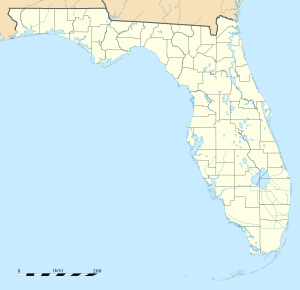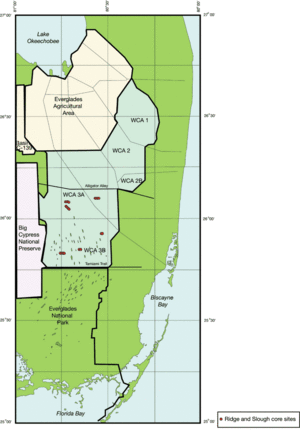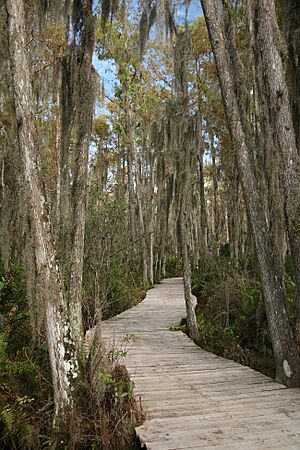Loxahatchee National Wildlife Refuge facts for kids
Quick facts for kids Arthur R. Marshall Loxahatchee National Wildlife Refuge |
|
|---|---|
|
IUCN Category IV (Habitat/Species Management Area)
|
|

Observation Platform overlooking the C-7 compartment on the Marsh Trail
|
|
| Location | Palm Beach County, Florida, United States |
| Nearest city | Boynton Beach, Florida |
| Area | 147,392 acres (596.47 km2) |
| Established | 1951 |
| Governing body | U.S. Fish and Wildlife Service |
| Website | Arthur R. Marshall Loxahatchee National Wildlife Refuge |
The Arthur R. Marshall Loxahatchee National Wildlife Refuge is a huge wildlife area in Florida. It's located west of Boynton Beach, in Palm Beach County. This special place is also known as Water Conservation Area 1 (WCA-1). It protects the northern part of the amazing historic Everglades wetland ecosystem.
The refuge covers over 145,000 acres of Everglades habitat. It sits next to farmlands on one side and cities on the other. The state of Florida owns this land, but the U.S. Fish and Wildlife Service manages it. They work to keep the wildlife healthy, restore the land, and offer fun activities for visitors.
Contents
About the Loxahatchee Refuge
The Arthur R. Marshall Loxahatchee National Wildlife Refuge is about seven miles west of Boynton Beach. It was created in 1951 to protect migratory birds. The refuge is managed by the U.S. Fish and Wildlife Service.
This refuge is one of three important water conservation areas (WCAs) in South Florida. It helps store water and control floods. It also provides a safe home for many native fish and wildlife. Water levels here are carefully controlled by pumps, canals, and levees. These structures were built by the Army Corps of Engineers. These freshwater areas, along with parts of Everglades National Park, are all that remain of the original vast Everglades.
Protecting the Refuge
The U.S. Fish and Wildlife Service works hard to protect the refuge. Their main goals are to restore the wetland habitat. This includes improving water quality and how water flows through the area. A big part of their job is controlling plants that don't belong there. These are called exotic or invasive plants.
Three of the biggest problem plants are melaleuca, Brazilian pepper, and Old World climbing fern. These plants grow very fast and can take over the native plants. The refuge works with many other state and federal groups in South Florida. Together, they try to solve these issues and restore the Everglades for the benefit of all wildlife.
What You Can See and Do
Loxahatchee NWR is one of over 500 national wildlife refuges in the United States. These refuges are managed by the United States Fish and Wildlife Service. This refuge not only protects wildlife but also offers fun things for people to do. You can find walking trails, a canoe trail, and a bike trail. There are also boat ramps, a fishing platform, and observation towers. Don't miss the butterfly garden and the visitor center!
The refuge is home to many animals. You might see American alligators, endangered snail kites, and different kinds of turtles. These include coastal plain cooter and Florida softshell turtles. There are also as many as 257 species of birds! Because of all the birds, it's a special 'gateway site' for the Great Florida Birding Trail.
Most of the refuge is Everglades marsh habitat. But there's also a 400-acre bald cypress swamp. This swamp is the largest part left of a cypress forest that once separated the pine forests from the Everglades marshes. A boardwalk goes right into the swamp. This lets you experience the swamp up close without getting your feet wet!
Fun Activities at the Park
The refuge allows many activities like fishing, hunting, and hiking. They also offer guided tours.
Fishing at the Refuge
You can fish in three areas: Hillsboro, Headquarters, and the 20-mile bend. Everyone fishing needs a valid fishing license from Florida. There are over 16 different types of fish you can catch in the refuge.
Hunting Opportunities
Hunting is allowed in the refuge to help manage animal populations. It's one of 330 refuges open for hunting. You can hunt waterfowl (like ducks) in the late fall and early winter. Hunters need a valid Florida State Hunting License and a Florida State Duck Stamp. Alligator hunting is only allowed with a special permit from the state of Florida.
Exploring Hiking Trails
There are many hiking trails throughout the refuge. One is the bald cypress swamp boardwalk, which is right behind the visitor center. Other trails can be reached from the Lee Road parking lot.
Guided Tours and Programs
The refuge also offers guided tours throughout the year. You can take canoe tours, night walks, and tram tours. Make sure to make a reservation for these!
Images for kids
-
Zebra Longwing at the butterfly garden
-
American white ibis by the boardwalk







